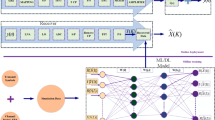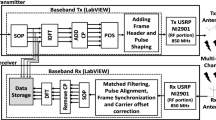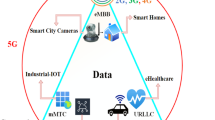Abstract
Interference degrades the performance of a correct data signal detection and decoding. This problem becomes rigorous when interferences are present during the period of channel estimation. This will wipe out the accuracy of channel estimation and will eventually result in a severe degradation in the performance of signal detection and decoding in the entire data packet/frame. In this article, we propose improved channel estimation techniques for multiband orthogonal frequency division multiplexing ultra-wideband system in narrowband interfering environment. In particular, we work towards preamble-based channel estimation techniques in the presence of unknown narrowband interference. The interference power on each subcarrier is considered as a nuisance parameter and is averaged out from the corresponding likelihood function. The later is then optimized in an iterative manner according to the quasi-Newton algorithm. Furthermore, we address highly accurate channel estimation in a time-variant channel due to sudden channel change and propose an iterative interpolation method and weighted channel estimation approach to reduce the effect of abrupt channel changes. Link level simulation results indicate that our proposed approaches outperform the conventional estimation methods.










Similar content being viewed by others
References
European Computer Manufacturer Association (2008) Standard ECMA-368: high rate ultra wideband PHY and MAC standard, 2nd edn. ECMA International, Dec
Islam SMR, Kwak KS (2010) A comprehensive study of channel estimation for WBAN-based healthcare systems: feasibility of using multiband UWB. J Med Syst 36(3):1553–1567. doi:10.1007/s10916-010-9617-6
Li Y, Molisch AF, Zhang J (2004) Practical approaches to channel estimation and interference suppression for OFDM based UWB communications. IEEE 6th CAS Symposium on Emerging Technologies: Mobile and Wireless Communications, Shanghai, China
Tsai Y-R, Wang C-C, Li X-S (2008) Adaptive channel estimation for MB-OFDM systems in multi-access interfering environments. IEEE Vehicular Technology Conference (VTC), Singapore, May
Hadaschik N, Zakia I, Ascheid G, Meyr H (2007) Joint narrowband interference detection and channel estimation for wideband OFDM. In: Proceedings of the European Wireless Conference, April
Islam SMR, Kwak KS (2011) Preamble-based improved channel estimation for multiband UWB system in presence of interferences. Telecommun Syst, doi:10.1007/s11235-011-9440-5
Islam SMR, Kwak KS (2011) Zero padded suffix aided subspace-based narrowband interference detected adaptive channel estimation for MB-OFDM UWB systems. Int J Phys Sci 6(1):52–64
Morelli M, Moretti M (2009) Channel estimation in OFDM systems with unknown interference. IEEE Trans Wirel Commun 8(10):5338–5347
Islam SMR, Ameen MA, Kwak KS (2011) Channel estimation in ECMA-368-based UWB systems with unknown interference. Telecommun Syst, doi:10.1007/s11235-011-9631-0
Foerster JR et al (2003) Channel modeling sub-committee report final. IEEE 802.15-02/490, Nov. 18
Muquet B, Wang Z, Ginnakis G, de Courville M, Duhamel P (2002) Cyclic prefix or zero padding for wireless multicarrier transmission? IEEE Trans Commun 50(12):2136–2148
Nocedal J, Wright SJ (1999) Numerical optimization. Springer Series in Operation Research, Springer, New York
Liu H, Zhong H, Zhang T, Gong Z (2006) A quasi-Newton acceleration EM algorithm for OFDM channel estimation. Inf Technol J 5(4):749–752
Nam SH, Yoon JS, Song HK (2008) EM-based low complexity channel estimation for OFDM system. IEEE Trans Consum Electron 54(2):425–430
Morelli M, Mengali U (2001) A comparison of pilot-aided channel estimation methods for OFDM systems. IEEE Trans Signal Process 49:3065–3073
Molisch A, Foerster J, Pendergrass M (2003) Channel models for ultra-wideband personal area networks. IEEE Commun Mag 10(6):14–21
IEEE 802.15 Working Group for Wireless Personal Area Networks (WPANs) (2002) Time Variance for UWB Wireless Channels. November
Li Y, Minn H, Jacobs T, Win MZ (2008) Frequency offset estimation for MB-OFDM-based UWB systems. IEEE Trans Commun 56(6):968–979
Keijo P, Koi V (2007) Iterative interpolation method for multiband-OFDM channel estimation. IEEE International Conference on Ultra-wideband (ICUWB), Singapore
Pagani P, Pajusco P (2006) Modeling the space- and time-variant ultra-wideband propagation channel. In: IEEE International Conference on Ultra Wide Band, Waltham, MA, USA
Pagani P, Pajusco P (2006) Characterization and modeling of temporal variations on an ultra-wideband radio link. IEEE Trans Antennas Propag 54(11–1):3198–3206
Acknowledgments
This research was supported by The Ministry of Knowledge Economy, Korea, under the Information Technology Research Centre support program supervised by the National IT Industry Promotion Agency (NIPA-2011-C1090-1121-0001).
Author information
Authors and Affiliations
Corresponding author
Appendix
Appendix
1.1 Cramer–Rao bound of proposed ML estimator
Taking the logarithm of  in (6), we get the log-likelihood function:
in (6), we get the log-likelihood function:

Assuming ideal knowledge of σ 2, the Fisher information matrix computed from the above equation leads to the inequality:
Using (4) and (5), (34) yields
where <A, B> is the inner product of A and B and the relation <A, B> = tr(B H A) has been used. Frobenius norm induced by the above inner product in (35) eventually leads to the following inequality:
1.2 IEEE 802.15.3a UWB channel model
The channel that we are concerned with is IEEE 802.15.3a UWB RF channel model that is given by,
where T l , τ r,l , and X are random variables representing the delay of the l − th cluster, the delay (relative to the l − th cluster arrival time) of the r − th multipath component of the l − th cluster and the log-normal shadowing, respectively. The channel coefficients are defined as a product of small-scale- and large-scale fading coefficients, i.e., α r,l = p r,l ξ l β r,l where p r,l takes on equiprobable ±1 to account for signal inversion due to reflections, and {1β r,l } are log-normal distributed path gains. Then, we have E[α r,l (T l , τ r,l )] = 0 and \( E\left[ {{{{\left| {{\alpha_{r,l }}\left( {T_l, {\tau_{r,l }}} \right)} \right|}}^2}} \right]={\varOmega_0}{e^{{{{{-{T_l}}} \left/ {\varGamma } \right.}}}}{e^{{{{{-{\tau_{r,l }}}} \left/ {\gamma } \right.}}}} \). Γ and γ are the cluster decay factor and ray decay factor, respectively. With different parameters, four typical environments are defined; they are CM1, CM2, CM3, and CM4. Note that CMj stands for channel model j.
Rights and permissions
About this article
Cite this article
Islam, S.M.R., Ullah, S. & Kwak, KS. Channel estimation in high date rate UWB system with unknown narrowband interference. Ann. Telecommun. 68, 503–514 (2013). https://doi.org/10.1007/s12243-012-0340-9
Received:
Accepted:
Published:
Issue Date:
DOI: https://doi.org/10.1007/s12243-012-0340-9




